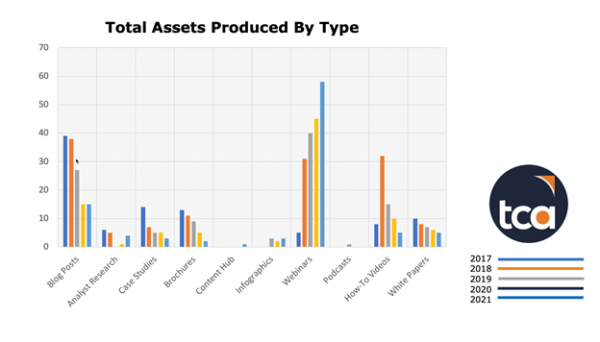 “This ship is just so hard to turn.”
“This ship is just so hard to turn.”
That phrase might sound familiar. I often hear it from clients, usually regarding some suggested change to existing processes. People lament the difficulty of doing something new because it requires changing or stopping something old.
Institutional momentum resists stopping (or changing). That’s true even when the answer to the question “Why not just stop doing the old thing?” is “I don’t know.”
Sometimes, you don’t know that you know.
Want an example? I worked with a B2B healthcare client who shared the balance of their content output by type for the last three years.

Each colored line represents the number of assets produced by content type – blog posts, analyst research, case studies, brochures, content hub, infographics, webinars, podcasts, how-to videos, and white papers – each year from 2017 to 2021.
The dramatic growth in webinars stands out. In 2017, the team produced less than 10. In 2018, the company got webinar fever and never looked back. The number of webinars grew substantially each year, while nearly all other content types declined. Webinars made up almost 60% of their total content output in 2021.
Your first reaction might be, “Webinars must really work for them.”
Nope. In fact, each year following 2018, webinars contributed less to lead generation (the primary goal) than the average contributed by all other content types.
Why did they continue to focus on webinars? Because. That’s why.
A B2B brand escalated its webinar count year after year even though the results were worse than other content types. Why? Just because, says @Robert_Rose via @CMIContent. #ContentStrategy Click To TweetIn 2018, the team got good at producing them. In 2019, a new content person joined and got the message to focus on webinars, so she doubled down.
In 2020, the team saw webinars as a safe way to continue their content program during the pandemic shutdowns. And, in 2021, they wanted to get back to the basics of what they had done for so many years. You guessed it: webinars.
They didn’t know what they knew.
Which window are you looking through?
A Johari window is a model for self-awareness and communication development based on two simple ideas: You learn by revealing information you know to be true and comparing that to the information you seek outside of yourself.
You can look through four windows:
- Things you know you know
- Things you know you don’t know
- Things you don’t know you don’t know
- Things you don’t know that you know
The fourth window probably represents the most insidious risk to success. It is the unknown known. Or, as it’s called in the Johari window, the façade.
Philosopher Slavoj Žižek categorized the unknown known as when people “intentionally refuse to acknowledge that we know.” In companies, you see this all the time. You all know the ship is moving in the wrong direction, but no one says it out loud.
But why?
Myriad business reasons explain why someone might not acknowledge something they know or believe. One researcher found the cause can be as simple as a team’s blind faith that a project could still have a chance at success.
In many cases, business leaders know they continue to do things with institutional momentum even though the programs aren’t productive or useful.
I worked with one team whose email newsletter subscriptions dropped from 10,000 to fewer than 100 over 18 months. Yet, they still spent thousands of dollars to develop the content and send that newsletter every quarter.
Stopping it, they thought, could signal to the C-suite that investment in that enterprise email system wasn’t worth funding.
Institutional momentum propels businesses to do things they know aren’t productive or useful, says @Robert_Rose via @CMIContent. #ContentStrategy Click To TweetMy healthcare client had a gut feeling that they produced sub-optimal webinars to the detriment of other types of content. But acknowledging the imbalance would mean addressing the fact that they had no strategy.
In other words, acknowledging the need to course-correct would imply that the team knew how many webinars they should produce and how to rebalance the mix of content types.
Look through all the windows
It’s tempting to look at the performance of content and campaigns and let the data inform how much to produce for any part of the journey, persona type, or format.
But let’s be honest, rebalancing any content or marketing strategy is never that simple.
First, you may not have easy access to all that information. Second, you may not agree on what those numbers mean, or you may not have developed common definitions across the company or even the team.
How does a video differ from a webinar? How does an e-book differ from a white paper? Do you know?
What new things haven’t you tried because you’re pressed for time? Where have you stuck with old patterns and habits because you believe your ship just won’t turn?
Do you know what you don’t know?
I find this version of a Johari window exercise a great place to start when reviewing a content and marketing strategy:
HANDPICKED RELATED CONTENT:
1. What old things are you confident you should continue doing? (You know what you know)
Pull together all that information and see what truly works.
At the healthcare company, white papers performed extraordinarily well for lead generation. Repurposing some webinars into white papers and integrating white papers into webinars helped a lot.
HANDPICKED RELATED CONTENT:
2. What new things should you add or change? (You know what you don’t know)
Can you identify new activities you should do but don’t because you lack skills, technology, content, or other capabilities?
The healthcare company tried launching a branded content hub but lacked the skills to do it properly. Instead, they identified a useful topic and devised a plan to execute it in a realistic time frame with outsourced resources.
3. What areas should you explore? (You don’t know what you don’t know)
You may have heard about or seen opportunities or options that would create efficiencies. If you feel you don’t understand much about those areas, consider how you can explore them.
The healthcare company heard its competitors had gained tremendous traction with a print magazine for healthcare providers. But no one on the existing team had experience with print. So they committed to exploring the intricacies and costs of setting it up and created a business case for it.
4. What things should you acknowledge that you know need to stop or change? (You don’t know what you know)
This window may be the most important for exploring your strategy.
Everyone on the healthcare company’s team acknowledged they produced too many webinars and didn’t get the results they wanted. Once they admitted this, they could rebalance their content strategy. They also committed to codifying a production measurement strategy to track how much they produced of any one kind of asset.
In sum, they turned the ship effectively.
Turning a strategy takes confidence
Setting a new course in content and marketing requires belief. Every winning approach succeeds partly because of a collective belief that it will succeed.
Your challenge is to make sure your can-do attitude doesn’t turn into a can’t-undo culture.
Make sure that can-do attitude doesn’t turn into a can’t-undo culture, says @Robert_Rose via @CMIContent. #ContentStrategy Click To TweetHANDPICKED RELATED CONTENT:
Get Robert’s take on content marketing industry news in just three minutes:
Cover image by Joseph Kalinowski/Content Marketing Institute

